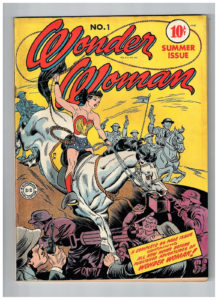Here’s a list that will make you money:
 If you own a vintage, 30 years old Nintendo or a vintage Atari, you can sell it to GenXer’s who may feel nostalgic for their distant past.
If you own a vintage, 30 years old Nintendo or a vintage Atari, you can sell it to GenXer’s who may feel nostalgic for their distant past.- If you own original Black Panther comic books, you’re in luck.
- If you have your mom’s mid-20th century furniture, you’ll have hordes of Millennials waving $100 bills at you.
- If you have a nice collection of political “Elect Me!” campaign memorabilia, plan to sell before November of 2020.
- If you have vintage female superhero comic books (Wonder Woman, Miss Marvel, Scarlet Witch, Black Widow) you’re in LUCK, but wait till the eponymous movies are announced, and sell.
- And if you have a designer vintage handbag in good shape, you’re golden.
My older clients who own other things, are sometimes disappointed. We recently consoled a number of clients who inherited stamp collections. Even if your granddad spent good money back in 1960 for stamps, you may not get the value out of them. Still worse is a collector of mine who thought she had some money in children’s board games. You’re going to see electronic games as hot, board games as NOT. And most books are not hot. Those things the BOOMERS treasured don’t attain the status of “hot collectible.” Those dead in the water Boomer treasures include English 18th century furniture, landscape paintings with cows, antique rugs, china services, our mother’s sterling. These items go for less than they did in 1980.
Solid reasons for this market shift today:
We now see a growing link between the object and the experience. Take vintage video games for example. By design those objects offered an experience. In a similar vein, vintage comic books, through movie franchises, have BECOME experiences.
Some hard data about the phenomena:
 The biggest market-share of buying power today belongs to the Millennial generation, the generation raised on experience, not static OBJECTS.
The biggest market-share of buying power today belongs to the Millennial generation, the generation raised on experience, not static OBJECTS.- Globally, millennials have $2.5 Trillion in spending power.
- In a recent poll, given a nice inheritance to spend, 76% of Millennials would purchase an “experience” (entertainment, travel, dining, concerts/stage events) rather than purchase an object.
- Even once the object is purchased, 76% of this age group are not loyal to any one object or brand. So collecting a genre of objects isn’t their GOAL.
- If an object is connected with an experience, then you have a good chance of a SALE.
Think of the recent furor over the death of Apple iTunes, in its 18th year. The world now mourns the passing of an experienced-based product. That’s because it has emotional resonance. The object itself, the small, sleek iPod (MP3 player), from which to run the Apple library of songs, marks the beginnings of a collection. For an analogy, think of cassette tapes, the Boomer’s music library, and the binder, or glovebox, held the library. The Walkman or car stereo played the song. An interesting mash up used the look alike to a cassette tape that actually worked as an MP3 player.
Every Millennial and late GenXers kept their music on iTunes. They curated their songs, traded, and ripped, opening it up for parties, listening and studying. Those became THEIR songs in a certain personalized library. The death of iTunes means the death of a personal experiential library. What listeners once filled with referential memories now sits empty. The perfect size and shape of an object to hold this, the iPod, now seems simply nostalgia, and memories of this devise are also the beginnings of the memories of how to COLLECT and CURATE. This personal library is now replaced by an infinite library. And the infinite is a scary and impersonal place to exist. Thus, the merging of the object and the experience creates value, not just dollar value, when an era ends.